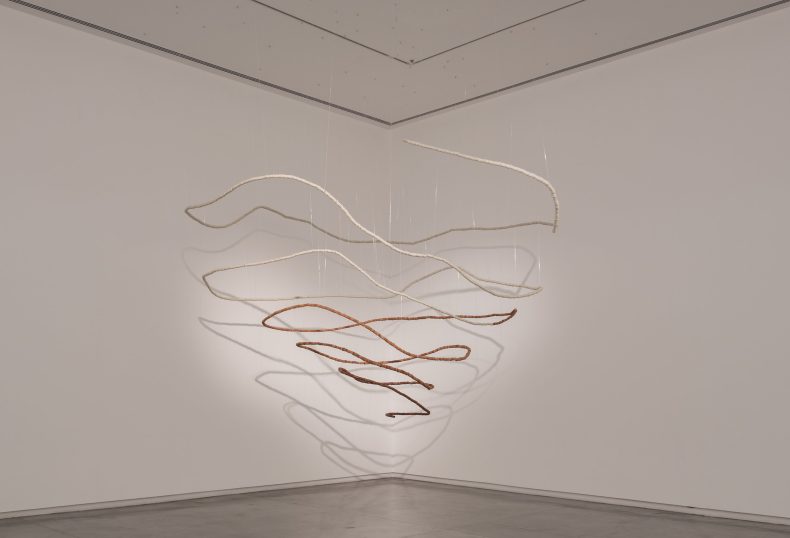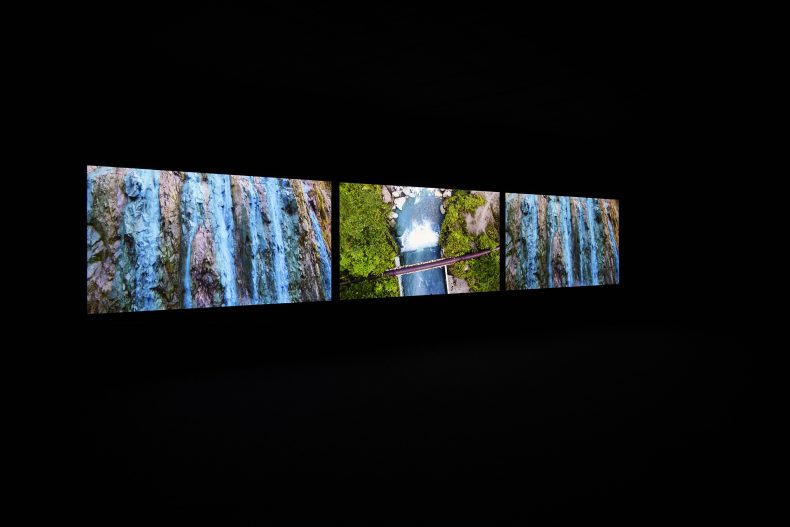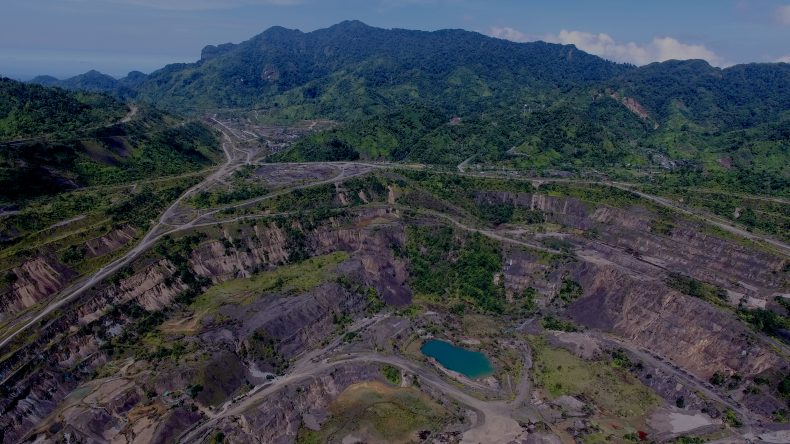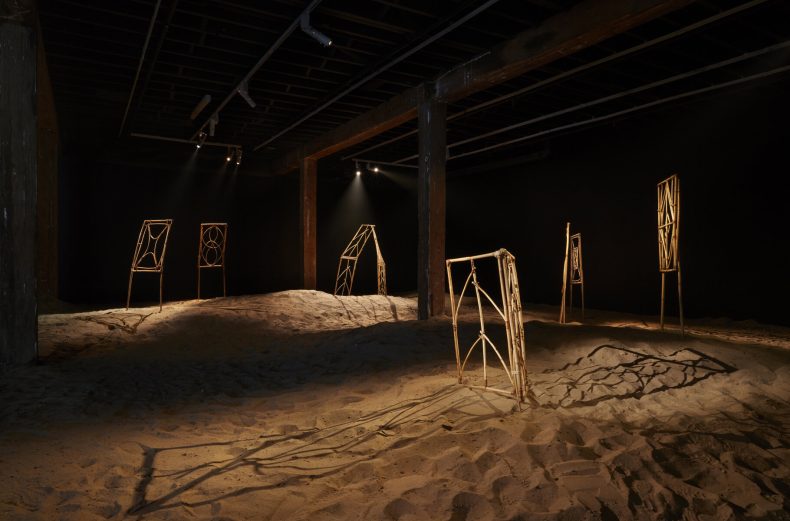If you were fortunate enough to visit the Berlin Biennale in 2022, you might have spent some quiet moments in awe of one installation in particular. A cone-shaped wire spiral, several metres high, suspended in the air and pointing downwards, was beaded from top to bottom with small pieces of stoneware, earthenware and white and terracotta porcelain. Taloi Havini’s Beroana (2015) is an evocation of shell money. On the land of the Nakas people in Bougainville, as well as in the neighbouring Solomon Islands, New Ireland and New Britain – all parts of Papua New Guinea today – women traditionally ground shell into beads and discs to assemble strings of currency. These customary valuables were not a form of cash, exchangeable for just about anything, but rather expressions of value necessary to the ceremonies that had long marked the life cycle, and in some places still do, in local matrilineal societies.

Beroana (2015), Taloi Havini. Courtesy Sharjah Art Foundation; © Taloi Havini
Havini, who is from the Nakas tribe, was awarded the 10th Artes Mundi prize last month. She has given artefacts, habitats and narratives from the southwest Pacific region of Melanesia unprecedented international prominence through her work in sculpture, installation, photography and video, exhibited in cities as diverse as San Francisco, Paris, Venice and Sharjah, as well as at the Asia-Pacific Triennial in Brisbane; her work has appeared extensively in Australia, where she studied and lives.
Her earlier work responded to museum artefacts, reflecting a family history marked by conflict in Bougainville since the late 20th century. At the time of Papua New Guinea’s independence from Australia in 1975, it was hoped that Bougainville’s Panguna copper mine – at one time the largest open-cut excavation on the planet – might fund the new nation’s economic development. The lack of local support and the adverse environmental impact of the project, among other issues, led to civil war throughout the 1990s, which was scarcely reported internationally despite causing tens of thousands of deaths.
Taloi’s father, Moses, a political leader, felt obliged to take the family to Australia to keep them safe. When Taloi was a child, he took her regularly to Sydney’s Australian Museum, where artefacts in storage gave her tangible access to the culture and heritage they had left behind. Beroana turned such museum objects inside out: the shell money ceases to be a treasure, hidden away in a box or drawer, and instead becomes a thing that occupies and defines a space. It is a light piece, in a double sense: through its apparent weightlessness and through the play of shadow on surrounding walls. It suggests that the environment is defined by the Melanesian gifts and protocols through which lives are lived.
Havini went on to produce a series of multi-screen video works and installations titled Habitat, shown at the Palais de Tokyo in Paris, the Asia-Pacific Triennial and in the Barbican’s recent ‘Re/Sisters’ exhibition, which was dedicated to feminism and ecology. It is currently on show in Cardiff and Llandudno as part of ‘Artes Mundi 10’, the exhibition the organisation has programmed around its 10th prize.

Habitat (2017), Taloi Havini. Photo: Stuart Whipps
The films, which play concurrently across three screens, dwell on the Bougainville landscape; they take us over and through the ruins of the Panguna copper mine and explore its effects on the environment and people’s lives. The videos are mesmerising, and need to be seen and heard rather than described. They are an absorbing evocation of place, sound and water, and of the extraction of mineral resources on a scale out of all proportion with the localised nature of life and territory in this part of the world. The Panguna mine closed 30 years ago, shortly after the civil war erupted, yet the pollution from tailings into the rivers is still obvious. The piece works through a combination of aerial and intimate views, moving between exposed rock and dirty water to the hands of a woman cutting fish, and a figure walking across what appears to be a desert landscape, who is then seen engaged in sieving the tailings. This artisanal extraction of minerals, an informal practice on the site of and physically connected with the industrial-scale mine, is at the very opposite end of the economic spectrum to the former multinational operation.

Still from Habitat (2017), Taloi Havini. Courtesy the artist and Silverlens
Havini’s subsequent projects have included Reclamation (2020), a collaboration with Nakas community members that extracts totemic motifs from customary architecture, particularly the cane frames that supported the thatched roofs of the clan houses known as tsuhana. As if to avoid replicating the model houses from the Pacific that were and still are prominent in German ethnographic museums, Havini did not reproduce the whole house, but rather pared the structure back to reveal the elements that exemplify ancestral ritual affiliation and identity.

Reclamation (2020), Taloi Havini. Photo: Zan Wimberley; © Taloi Havini
Taloi Havini is not the only artist from contemporary Oceania to address custom, history, empire and diaspora across a range of media, but her renderings of the spaces, dwellings and artefacts of her ancestors, and of the carnage inflicted by a single colossal mine, are uniquely eloquent and powerful.
Nicholas Thomas co-curated ‘Oceania’ for the Royal Academy and the Musée du quai Branly – Jacques Chirac in 2018–19. His most recent book is Gauguin and Polynesia (Head of Zeus, 2024).

Chaos into calm – the art of Taloi Havini
Taloi Havini. Photo: Zan Wimberley
Share
If you were fortunate enough to visit the Berlin Biennale in 2022, you might have spent some quiet moments in awe of one installation in particular. A cone-shaped wire spiral, several metres high, suspended in the air and pointing downwards, was beaded from top to bottom with small pieces of stoneware, earthenware and white and terracotta porcelain. Taloi Havini’s Beroana (2015) is an evocation of shell money. On the land of the Nakas people in Bougainville, as well as in the neighbouring Solomon Islands, New Ireland and New Britain – all parts of Papua New Guinea today – women traditionally ground shell into beads and discs to assemble strings of currency. These customary valuables were not a form of cash, exchangeable for just about anything, but rather expressions of value necessary to the ceremonies that had long marked the life cycle, and in some places still do, in local matrilineal societies.
Beroana (2015), Taloi Havini. Courtesy Sharjah Art Foundation; © Taloi Havini
Havini, who is from the Nakas tribe, was awarded the 10th Artes Mundi prize last month. She has given artefacts, habitats and narratives from the southwest Pacific region of Melanesia unprecedented international prominence through her work in sculpture, installation, photography and video, exhibited in cities as diverse as San Francisco, Paris, Venice and Sharjah, as well as at the Asia-Pacific Triennial in Brisbane; her work has appeared extensively in Australia, where she studied and lives.
Her earlier work responded to museum artefacts, reflecting a family history marked by conflict in Bougainville since the late 20th century. At the time of Papua New Guinea’s independence from Australia in 1975, it was hoped that Bougainville’s Panguna copper mine – at one time the largest open-cut excavation on the planet – might fund the new nation’s economic development. The lack of local support and the adverse environmental impact of the project, among other issues, led to civil war throughout the 1990s, which was scarcely reported internationally despite causing tens of thousands of deaths.
Taloi’s father, Moses, a political leader, felt obliged to take the family to Australia to keep them safe. When Taloi was a child, he took her regularly to Sydney’s Australian Museum, where artefacts in storage gave her tangible access to the culture and heritage they had left behind. Beroana turned such museum objects inside out: the shell money ceases to be a treasure, hidden away in a box or drawer, and instead becomes a thing that occupies and defines a space. It is a light piece, in a double sense: through its apparent weightlessness and through the play of shadow on surrounding walls. It suggests that the environment is defined by the Melanesian gifts and protocols through which lives are lived.
Havini went on to produce a series of multi-screen video works and installations titled Habitat, shown at the Palais de Tokyo in Paris, the Asia-Pacific Triennial and in the Barbican’s recent ‘Re/Sisters’ exhibition, which was dedicated to feminism and ecology. It is currently on show in Cardiff and Llandudno as part of ‘Artes Mundi 10’, the exhibition the organisation has programmed around its 10th prize.
Habitat (2017), Taloi Havini. Photo: Stuart Whipps
The films, which play concurrently across three screens, dwell on the Bougainville landscape; they take us over and through the ruins of the Panguna copper mine and explore its effects on the environment and people’s lives. The videos are mesmerising, and need to be seen and heard rather than described. They are an absorbing evocation of place, sound and water, and of the extraction of mineral resources on a scale out of all proportion with the localised nature of life and territory in this part of the world. The Panguna mine closed 30 years ago, shortly after the civil war erupted, yet the pollution from tailings into the rivers is still obvious. The piece works through a combination of aerial and intimate views, moving between exposed rock and dirty water to the hands of a woman cutting fish, and a figure walking across what appears to be a desert landscape, who is then seen engaged in sieving the tailings. This artisanal extraction of minerals, an informal practice on the site of and physically connected with the industrial-scale mine, is at the very opposite end of the economic spectrum to the former multinational operation.
Still from Habitat (2017), Taloi Havini. Courtesy the artist and Silverlens
Havini’s subsequent projects have included Reclamation (2020), a collaboration with Nakas community members that extracts totemic motifs from customary architecture, particularly the cane frames that supported the thatched roofs of the clan houses known as tsuhana. As if to avoid replicating the model houses from the Pacific that were and still are prominent in German ethnographic museums, Havini did not reproduce the whole house, but rather pared the structure back to reveal the elements that exemplify ancestral ritual affiliation and identity.
Reclamation (2020), Taloi Havini. Photo: Zan Wimberley; © Taloi Havini
Taloi Havini is not the only artist from contemporary Oceania to address custom, history, empire and diaspora across a range of media, but her renderings of the spaces, dwellings and artefacts of her ancestors, and of the carnage inflicted by a single colossal mine, are uniquely eloquent and powerful.
Nicholas Thomas co-curated ‘Oceania’ for the Royal Academy and the Musée du quai Branly – Jacques Chirac in 2018–19. His most recent book is Gauguin and Polynesia (Head of Zeus, 2024).
Unlimited access from just $16 every 3 months
Subscribe to get unlimited and exclusive access to the top art stories, interviews and exhibition reviews.
Share
Recommended for you
Sea change – a fresh perspective on the art of Oceania
A rehang of Christchurch Art Gallery’s permanent collections emphasises non-European patterns of influence
A question of ethics – the market for African and Oceanic art
As museums make promises to return looted works of art, provenance is now of paramount importance in the market
We need ethnographic museums today – whatever you think of their history
Ethnographic collections need to be living collections, representative of cultural diversity and mindful of traditions